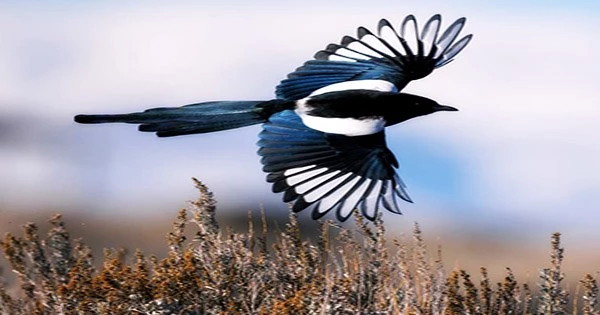The western half of North America is home to the black-billed magpie (Pica hudsonia), also referred to as the American magpie. Western landscapes benefit greatly from the flamboyant appearance of black-billed magpies and their large bushel-basket nests they build in trees. Farmers and ranchers attempted to eradicate this plant in the past, but their efforts were unsuccessful, and it is now widespread in open areas and even in mountain west communities. It is black and white, with black areas on the wings and tail showing iridescent hints of blue or blue-green. It is one of only four North American songbirds whose tail makes up half or more of the total body length (the others being the yellow-billed magpie, the scissor-tailed flycatcher, and the fork-tailed flycatcher). Externally, it is almost identical with the European Magpie, Pica pica, and is considered conspecific (one single species) by many sources. The American Ornithologists’ Union, however, splits it as a separate species, Pica hudsonia, on the grounds that mtDNA sequence studies place it closer to California’s Yellow-billed Magpie, Pica nuttalli, than to the European Magpie. If this theory is valid, the Pica pica sericea Korean subspecies of the European Magpie should likewise be regarded as a distinct species. This species favors settings that are mainly open and contain groups of trees. As a result, it can be found in rural and suburban regions where it frequently interacts with people. Where it is being persecuted, it gets extremely apprehensive, but otherwise, it tolerates people rather well. It used to land on the backs of bison herds, but now it flies above livestock in search of insects and ticks. Large predators such as wolves are commonly followed by black-billed magpies, who scavenge from their kills. The species also walks or hops on the ground, where it obtains food items such as beetles, grasshoppers, worms, and small rodents. The black-billed magpie is one of the few North American birds that build a domed nest, which is made up of twigs and sits near the top of trees, usually housing 6–7 eggs. Incubation, by the female only, starts when the clutch is complete, and lasts 16–21 days. The nestling period is 3–4 weeks. Their extremely long tails trail behind them as they sit on fenceposts, traffic signs, and rangelands while flashing white wing patches. This huge, showy relative of crows and jays is a gregarious bird that congregates in groups to eat carrion. In addition to being outspoken, they frequently make loud or obnoxious calls.

Black-billed Magpies are slightly larger than jays with much longer, diamond-shaped tails and heavier bills. In flight, their wings seem to be too short to support their graceful flight. The black-billed magpie is a mid-sized bird that measures 45–60 centimeters (18–24 in) from tip to tail. The middle pair of the tail’s long, layered feathers protrudes the furthest from the body. Oblong and very slightly bent at the tip, the beak is. Although there may be overlap between the sexes, the black-billed magpie is dimorphic in size and weight unlike other Corvidae family members. Males are, on average, six to nine percent larger and sixteen to twenty-four percent heavier than females, at 167–216 grams (5.9–7.6 oz), a wingspan of 205–219 millimeters (8.1–8.6 in), and tail lengths of 230–320 millimeters (9.1–12.6 in). Females weigh between 141–179 grams (5.0–6.3 oz), have wingspans of 175–210 millimeters (6.9–8.3 in), and tail lengths of 232–300 millimeters (9.1–11.8 in). These birds are black and white overall with blue-green iridescent flashes in the wing and tail. The upperparts are mostly black with a white patch in the outer wing and two white stripes (“backpack straps”) on the back. Black-billed Magpies are noisy, and they have a habit of sitting very conspicuously at the tops of trees or fenceposts, so they can be easy to hear and see. In flight their trailing tail feathers and bright, flashy white wing patches make them unmistakable. Keep an eye in the air for their graceful, gliding flights across open, brushy areas. Black-billed magpies range in the north from Alaska, central western British Columbia, Alberta, Saskatchewan, and southern Manitoba, through the Rocky Mountains down south to all the Rocky Mountain states including New Mexico, Colorado, Wyoming, Idaho, and some bordering states as well. It frequents open country with thickets and scattered trees, especially riparian groves, but can be found within cities as well. Black-billed Magpies are social, inquisitive birds that eat fruits, grains, insects, small animals, and frequently gather in large flocks at carrion. Magpies move in groups and give a variety of trill, cackle, and whistle calls. They flap steadily in flight, alternating deep and shallow wingbeats, and use their very long tails to negotiate abrupt turns. Adult magpie pairs stay together year-round and usually for life unless one dies, in which case the remaining magpie finds another mate. During the breeding season the preferred habitat is riparian areas with thickets. The predilection for open habitats with clumps of trees means that the species also breeds in some meadows and suburbs. Outside the breeding season, magpies can be found in their breeding habitat but also near feedlots, grain elevators, landfills, and around barns and houses. The female lays up to thirteen eggs, but the usual clutch size is six or seven. The eggs are greenish grey, marked with browns, and 1.3 inch long. Only the female incubates, for 16–21 days. The male feeds the female throughout incubation. The longest-living Black-billed Magpie on record was at least 9 years, 5 months old when it was recaptured and rereleased in Saskatchewan in 2021. Especially during the first half of the 20th century, black-billed magpies were considered detrimental to game-bird populations (they sometimes steal bird eggs) and domestic stock (they may sometimes peck at sores on cattle), and were systematically trapped or shot. Bounties of one cent per egg or two cents per head were offered in many states. Toxic chemicals, particularly insecticides sprayed topically to livestock’s backs, are detrimental to the general population of black-billed magpies. This presents a challenge since black-billed magpies occasionally remove ticks from the backs of cattle.
















